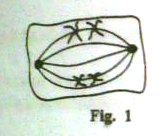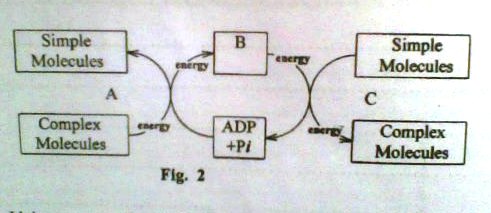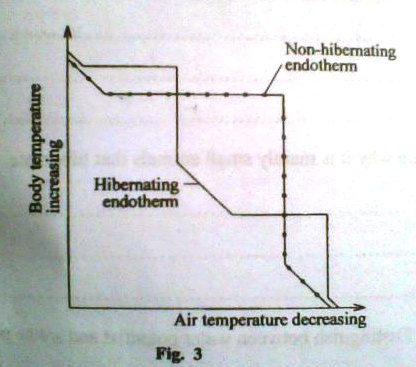1. Which one of the following methods is used by the bony fish to regulate its internal environment?
A. Actively takes up salts through its gills
B. Constantly drinks water
C. Produces isotonic urine in small quantities
D. produces dilute urine in large quantities
2. Which one of the following animal tissues serves a similar function like the parenchyma tissue in plants?
A. Collagen tissue
B. Cartilage tissue
C. Elastictissue
D. Areolar tissue.
3. The DNA of an organism contains 17.5% cytosine nucleotides. What would be the percentage of thymine nucleotides in its DNA?
A. 96.5
B. 65.0
C. 60.0
D. 32.5
4. An organism was found to posses conspicuous flagella, chloroplasts and a protein coat. The phylum to which the organism belongs is the
A. protozola
B. chlorophyta
C. ascomycota
D. bryophyte
5. In birds, hatchlings following the first thing they see, is an example of
A. insight
B. association
C. habituation
D. imprinting
6. Which one of the following situations could result in evolution? When
A. organisms have adapted to the new environment
B. there is inbreeding
C. genetic equilibrium is upset
D. there is no gene flow in a population
7. Which one of the following graphs shows the correct relationship between the rate of breathing with increase in amount of exercise in an athlete?
8. Ina heavily polluted aquatic ecosystem, the group of organisms with the highest concentration of pollutants in their bodies are the
A. tertiary consumers
B. secondary consumers
C. primaryconsumers
D. primary producers
9. During photosynthesis, the carbon fixing compound is produced from
A. glucose
B. glycerate-3-phosphate
C. unstable 6-carbon sugar
D. triose phosphate
10. During muscular contraction, the release of Ca2+ causes
A. myosin binfing sites to be exposed
B. tropomyosin to attach to myosin
C. myosin to detach from actin
D. troponin to bind with actin
11. Which one of the following is not an advantage of insects having larval forms that are markedly different from adults?
A. Allows the species to survive predators
B. Enables adults to recognize their young easily
C. Allows the species to exploit different food sources
D. Limits stiff competitions between adults and larvae
12. Hemophilia is sex-linked trait caused by a recessive gene. When a normal man marries a carrier woman for haemophilia, the probability of the couple producing a normal son is
A. 0%
B. 25%
C. 50%
D. 75%
13. A plant has 20 chromosomes in its receptacle cells. What would be the number of chromosomes in its endosperm cells?
A. 80
B. 40
C. 30
D. 10
14. Which one of the following least favors the emergence of species?
A. Selective breeding
B. Stable environmental conditions
C. Artificial selection
D. Gene flow in a population
15. Which one of the following organisms A,B,C and D would most require a vascular system?
|
Organism |
Surface are (cm2) |
Volume (cm3) |
|
A. |
1 |
0.25 |
|
B. |
6 |
3 |
|
C. |
16 |
10 |
|
D. |
12 |
8 |
16. Which one of the following is responsible for destroying worn out organelles in a cell?
A. Lysosome
B. Ribosome
C. Endoplasmic reticulum
D. Mitochondria
17. Which one of the following features of fungi differentiates them from other heterotrophs?
A. Storing carbohydrate as glycogen
B. Absorbing nutrients by active transport
C. Digesting food outside the body
D. Obtaining carbon from organic materials
18. What stage of cell division is shown in figure 1?
A. Metaphase of mitosis
B. Metaphase of meiosis
C. Prophase II of meiosis
D. Metaphase of meiosis
19. The rate of an enzyme controlled reaction becomes constant at a certain poin with increasein substrate concentration because
A. enzymes are denatured
B. active sites become fully occupied
C. end-product inhibition occurs
D. cofactors become used up
20. Which one of the following would occur at a synapse treated with a poison which renders cholinesterase inactive?
A. Conduction of impulses ceases
B. Conduction speed of impulses reduces
C. Conduction of impulses in post synaptic neurone continues
D. The direction of impulses reverses
21. The oxidation of a respiratory substrate occurs according to the following equation:
C18H36O2 + 26O2 -> 18CO2 + 18H2O
What isits respiratory quotient after complete oxidation in the body?
A. 0.7
B. 0.8
C. 0.9
D. 1.0
22. Which one of the following explains why sucrose is a good transport substance in plants? It
A. can easily be hydrolyzed
B. easily enters the general metabolic pathways
C. has high solubility this forming high concentration
D. is highly abundant in plants
23. The mammalian eye receives fewer stimuli per unit time compared to insect compound eye because the
A. mammalian eye occupies a smaller part on the head than the insect eye
B. mammalian eye has less focusing units than the insect eye
C. time lapse between reception of light, stimulus and recovery is shorter in the insect eye
D. mammalian eye has a smaller field of view
24. The type of learning that prevents the animal from responding to repeated stimulation is
A. insight
B. conditioning
C. imprinting
D. habituation
25. What are the triplet bases in the template DNA strand if the anticodon of the tRNA is ACG?
A. ACG
B. UGC
C. TGT
D. GGC
26. Denitrifying bacteria reduce nitrates in order to
A. release energy for their respiration
B. take up carbon dioxide in the environment
C. release carbon dioxide in the environment
D. release oxygen for their respiration
27. Which one of the following is an effect of auxins in plant growth? It inhibits
A. fruit formation
B. the development of side branches
C. growth of the entire plant
D. growth of adventitious roots
28. Which one of the following occurs in haploid parthenogenesis? Eggs are formed by
A. meiosis and develop without being fertilized
B. mitosis and develop without being fertilized
C. meiosis and are fertilized
D. mitosis and are fertilized
29. Which one of the following is true about the contracted mammalian muscle fibril? The
A. light part of the A-band increases
B. I-band and H-zone increases
C. dark ends of the A-band increase
D. dark ends of the A – band decrease
30. An individual with diabetes insipidus feels thirsty most of the time because
A. glucose in the urine causes less water to be lost in form of urine
B. there is dehydration due to much water loss
C. glucose removed from the blood stream appears in small amounts in urine
D. glucose regulation is an endothermic reaction in which heat energy is absorbed
31. Mosquitoes are successful feeders on human blood because they
A. possess specialized mouth parts
B. employ many phases in their development
C. release anti-coagulant into the human blood
D. have attachment devices
32. Which one of the following is true when the ovum is not fertilized in humans?
A. The Graafian follicle increases in size
B. The uterine lining thickens
C. The Graafian follicle degenerates
D. Ovulation occurs
33. An adult whose diet consists of only milk may suffer from
A. insufficient iron synthesisi
B. low energy content
C. high fat contents which blocks the bone marrow
D. break down of red blood cell
34. Which of the animals A, B, C and D would have the highest rate of diffusion across its surface?
|
Animal |
Surface Area (mm2) |
Volume (mm3) |
|
A. |
2 |
1 |
|
B. |
4 |
10 |
|
C. |
6 |
20 |
|
D. |
8 |
40 |
35. In which one of the following organisms is the gametophyte a dominant generation?
A. Ferns
B. Mosses
C. Conifers
D. Flowering plants
36. Which of the following explains why intercellular fluid is draen back at the venous end of the capillary?
A. Fewer blood capillaries at the venous side
B. Low levels of ultra-filtration at the venous end
C. High blood pressure at the venous end
D. High osmotic pressure of plasma proteins
37. In estimating the population of a weed in an area of 1000m2, a 1m2 quadrat was thrown 50 times and the total number of weeds counted were 60. What was estimated population of the weed?
A. 20
B. 300
C. 833
D. 1,200
38. Whales and sharks are aquatic animals with stream lined shapes, dorsal fins, flippers and large tails yet they are not of the same class. This is an example of
A. divergent evolution
B. convergent evolution
C. adaptive radiation
D. natural selection
39. Dioecious plants are rare despite the advantages of cross pollination because of
A. increased distance between individual plants which requires a lot of space
B. increased competition among the plants for resources
C. production of few seeds
D. large wastage of pollen
40. The following processes are involved in bulk transport of materials in a cell except
A. exocytosis
B. phagocytosis
C. diffusion
D. pinocytosis
SECTION B
Write answers in the spaces provided
41. a) What is a limiting factor?
b) Describe a state where carbon dioxide is limiting factor in photosynthesis
c) Give three differences between the light dependent and light independent reactions of photosynthesis.
42. a) Explain the effects of the following:
i) Heterozygote advantage in a population with increasing gene flow
ii) Isolation of individuals of a population for generations
b) Explain why the sickle cell trait is prevalent in malaria prone areas
43.a) Give the importance of synapses in the nervous system
b) Explain why the;
i) production of acetylcholinesterase at the synapse is important during nerve impulse transmission
ii) impermeability of the axon membrane to sodium ions in a part of a neuron helps to maintain the resting potential in that part.
44. Figure 2 shows the transfer of energy in catabolic and anabolic reactions in a living cell
a) Using arrows X and Y show the direction of the catabolic and anabolic reactions respectively on figure 2.
b) Name the compound marked B and one example of the processes represented by A and C
c) Outline two roles of ATP in living cells
d) ive three differences between oxidative phosphorylation and photosphorylation.
45. Figure 3 shows the relationship between air temperature from summer through winter and body temperature of hibernating and non-hibernating endotherms.
a) Explain the changes in the body temperature when the air temperature decreases in the;
i) hibernating endotherm
ii) non-hibernating endotherm.
b) What is the importance of hibernation in mammals that live in cold regions?
c) Explain why it is mainly small animals that hibernate.
46. a) i)Distinguish between water potential and solute potential
ii) Explain why the water potential in the roots is higher than the water potential in the leaves in plants.
b) Describe how the;
i) root pressure contributes to the transport of water in plants.
ii) structure of cells of the endodermis is adapted for their role of transport of water in a plant
END




